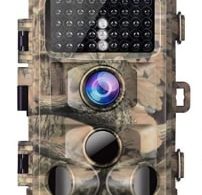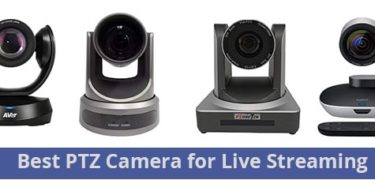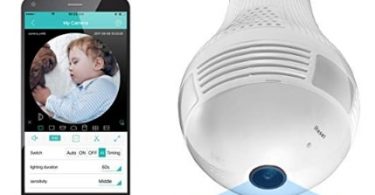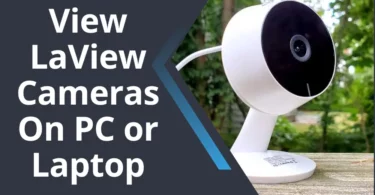As an Amazon Associate, I can earn from qualifying purchases. Learn more.
Why do you have or want to have CCTV cameras on your property? The answer for most people is to enhance security and or productivity. But then begs the question, is the technology reliable? If we say yes, how do security cameras work in cold weather without issues?
Well, a security camera is a machine like any other. It has its requirements to work or even just power on. One of these requirements is the appropriate working temperature. And when we say “appropriate temperature”, the results vary on whether you have a dedicated cold weather security camera or the regular system.
Neither Too Cold nor Too Hot Temperature is Good
In this guide, our focus is on whether security cameras work in cold weather. Before we come to that, though, you should know high temperatures aren’t great for systems either.
As a matter of fact, extremely hot temperatures are a far greater danger to CCTV systems than cold conditions.
You have ever had an overheated phone, tablet, laptop, or desktop computer, right? The way these devices freeze or start malfunctioning after overheating will affect security cameras the same way in extreme heat.
For instance, the malfunctions can be the CCTV camera restart or power off anyhow. You may also experience an abrupt video loss, despite the device being on.
Since we’re talking about an electronic here, the high external temperatures could cause your system to overheat. And in extreme heat levels, the internal components may fry to an unrepairable state.
Another thing, many of the wireless security cameras in the market have been coming with plastic housing. The material in some brands, like Arlo security cameras, feels durable. But at the end of the day, plastic is a huge enemy of heat, where extreme levels will trigger degradation and later disintegration.
Speaking of levels, extreme heat tends to drain the charge level of battery-powered security cameras faster than normal. Then again, cold weather may have a far worse effect (of high battery discharge).
What Can Happen to Security Cameras in Cold Weather
Similar to heat, cold temperatures will affect your security cameras in a number of ways. Differently, though, the cold temperatures can be just frigid or accompanied by rain, sleet, or snow. Thus, the impact on your system will vary on the condition.
The first of these impacts is what we’ve just mentioned above- the battery life. And what happens is that (Lithium-ion) batteries usually produce less current during cold temperatures from slowed chemical reactions.
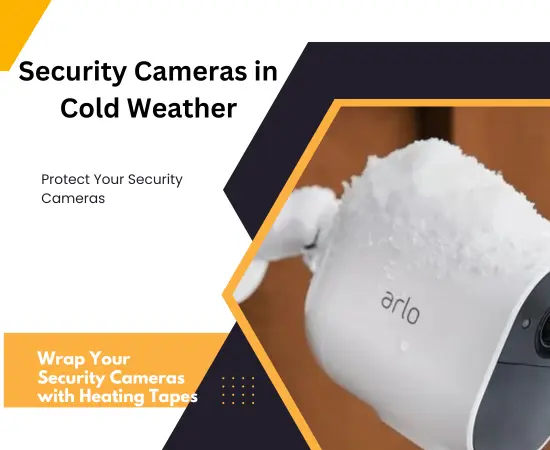
When the chemistry inside the battery is slow, the CCTV will be unable to hold a charge, causing it to run out of power faster than expected. In the end, you’ll have to recharge the cameras more often.
At some point, when the temperature is too low, your rechargeable security cameras will refuse to recharge. Then when the power runs out, the device will stop functioning altogether.
Reputable brands, say Blink vs Ring, have guidelines on the crucial temperature ranges for your security cameras. The Ring support team has even listed on their page the temperatures at which the battery may stop working:
- 36°F (3°C): at this temperature, the battery start to have trouble holding charge effectively, which then will require you to recharge more frequently.
- 32°F (0°C): at this temperature, the battery may fail to charge at all. When you even hardwire the system, the battery may still not charge.
- -5°F (-20°C): At this temperature, the battery may stop working completely. It’s only until the temperatures warm up the device will start to work again.
Cold Weathers Could Affect Your Security Camera Visibility
Besides the issues of battery, cold weather can also affect the visibility of your security camera system. It happens when the water vapor in the air condenses on the camera lens when the temperatures get low.
If the air moisture condenses at the “dew point”, the CCTV camera will be wet with dew. And just like when it’s raining, the drops of dew on the lens will result in a blurry video recording.
If the air is even colder to the “frost point”, the water droplets will crystallize into bits of ice. This may end up with a thicker block on the lens of the security camera, leading to complete video loss.
Tip: dew point is a temperature at which the water vapor in the air will condense (during cold weather) and becomes liquid. In a nutshell, the dew point usually varies with the weather, location, and time of the day. When in locations with very warm, humid conditions, dew can start to form when the temperature reaches 75 to 77°F (sometimes 80°F).
During colder weather when the temperatures drop below freezing (at or below 32°F/ 0°C), this is now the frost point.
Cold Weathers Can Affect Other Components of Your Security Cameras
When the frost forms on your security cameras, visibility isn’t the only thing to be concerned about. If your device doesn’t have the best sealing, drops of water can start to seep inside when the ice starts to melt. Then this may end up shorting the circuitry, causing damage that may be expensive to repair or unrepairable.
If you have an auto-tracking security camera, the frost can also hinder the side-to-side movements. When the frost liquefies and meets dirt in the rotary part, it could end up with an even more severe clog-up.
Furthermore, when the ice liquefies over the chipped paint of your Vandalprof security cameras, they could start rusting. If not handled on time, the rust will progress to severe corrosion, which will later end up with holes in the housing. Then this will leave the internal components of the device exposed to other harsh weather elements.
Do Security Cameras Work in Cold Weather?
A quick answer, YES, security cameras work in cold weather. However, not all the cameras will work efficiently. Why so?
As we mentioned in the beginning, you’ll come to find in the market security cameras dedicated to cold weather. The cameras may not exactly claim to be tolerant of the cold weather (some may claim). But when you check the spec sheet of this kind of system, it will show capable to work in super-low temperatures.
For example, when we go back to Amazon’s brands Ring and Blink, their outdoor security cameras have a working temperature of as low as -20° C (-4° F). “Outdoor security cameras” is the keyword here, as indoor CCTV systems usually don’t have protection for severe weather conditions.
Nevertheless, during the winter months, the temperatures inside the house drop as well. And for this reason, a good indoor security camera should be able to withstand at least the freezing point.
The drawback is that indoor cameras usually don’t have good ingress protection (IP). Ingress protection defines the ability of the CCTV camera to withstand penetration by foreign bodies and water.
IP65 means your security camera is totally dust tight (or fully protected against foreign bodies) and can withstand low-pressure water jets. Thus, when the snow covers the camera, neither the snow nor liquefied water should seep through to the internal components.
Sadly, many CCTV systems in the market are generic brands that just fabricate specs like IP and performance features. They can say on the spec sheet they are IP67-rated (just to boast more sales), only to find the lens filled with water the next day.
Verdict:
So, when looking for the best security cameras for cold weather, go for reputable brands. Reputable companies usually put their products through various rigorous tests to make sure they work as intended/ advertised.
Keep in mind, a high IP rating doesn’t mean your security cameras will automatically work in cold weather. You still must make sure the devices have working conditions suitable for cold temperatures. And the colder your area, the lower the operating range should be.
For instance, a state like Alaska (or Manitoba Canada) can get as cold as -30°F (-34°C) during the winter months. In this case, many WiFi security cameras, including our Ring and Blink brands, will not work. You’ll need a commercial-grade CCTV system- the likes of WTI Sidewinder, Lorex, and GW Security have operating temperatures of -40°F (-40°C).
Other Ways to Make Sure Your Security Cameras Work in Cold Weather
Besides the ingress protection and low operating temperature, other ways to help make sure your security cameras work in cold weather include:
· Mount Your Security Camera at an Ideal Location
The first alternative way to make sure your security camera work in cold weather is to mount them under a shade, away from the open environment. A perfect example is under the eaves or awning, as the shelter will make sure the device gets the morning sunlight to “melt” the condensation from the dewpoint.
· Monitor the Health of Your Security Camera
You’ll also want to keep an eye on your security cameras at all times. If you have paired your system with a mobile app for remote viewing, keep track of the health status.
In the health monitor, you should be able to see the charge level of your battery-powered CCTV cameras. It will even start to show a warning alert when the battery is low.
Reputable brands like Ring, Blink, and Arlo have a built-in temperature sensors. The Ring camera even has the option to set when it detects water. Then you’ll get real-time alerts to get prepared for the next precautionary measure.
During the winter season, you should also physically inspect your cameras. Then clean off any snow, water droplets, and even dirt that may be on the surface- especially on the lens and where the camera face closes on the body.
· Always Have Fully-Charged Spare Batteries
We saw one of the effects of security cameras during cold weather is the baby discharging quickly. To be on the fair, you should be ready to recharge the system more often than usual.
If the camera is in a high mounting location where the charger can’t reach, we’d recommend you get some extra spare batteries. And this will ensure you only need to replace the nearly discharged battery with a fully charged pack.
· Protect Your Security Cameras with Anti-Fog Film/ Anti-Fog Spray
Do you have a pro biker or diver at home? The anti-fog spray or anti-fog film that bikers and swimmers/ divers use to fight condensation on their helmets/ goggles can also help your security cameras work in cold weather better.
What the anti-fog spray/ film does is keep the dew away from the surface of the camera. Thus, minimizing the risk of blurry videos and internal circuitry damage.
· Protect Your Security Cameras with an Enclosure
Have you seen online pics of how enthusiastic gardeners protect their gems against frost? We can use a similar idea to protect security cameras against cold weather elements. But instead of the winter plant covers, build/ get a small structure for the camera- a birdhouse work best.
Make sure your birdhouse has a window where the lens can look out through in full coverage without obstruction.
Ps. The birdhouse idea is handy when you want to mount your security cameras in the open without the eaves/ awning.
· Wrap Your Security Cameras with Heating Tapes
If your security cameras are suffering from extreme cold and freeze, wrapping them with heating tapes can help. The online market (and local retailers) have a wide array of these heating tapes. All you need to do is find a flexible piece that you can wrap around the camera to keep it warm when it gets freezing.
As a matter, some of the premium heating tapes will not only keep your security cameras within the operating temperatures. The tapes will also get rid of ice around the camera area.
· Bring Your Security Cameras Inside the House
If the cold caught you at a bad time and your security cameras suddenly scream it’s freezing outside, bring them inside the house. Even on brands like Wyze that don’t show the temperature rating, you’ll be surprised your previously dead camera powers up after bringing it indoors where it’s warm.
Final Thoughts:
As we concluded, you can indeed see security cameras do work in cold weather. But for the best results, make sure your CCTV can efficiently handle severe conditions. Otherwise, you’ll be at a total loss when you have a phony product that will barely make it out the next morning.
The most crucial point to keep in mind is that your security should have at least IP65 protection and operating temperatures from as low as -5°F/ 20°C. Or else at least the freezing point at 32°F/ 0°C.
